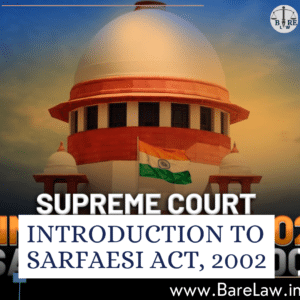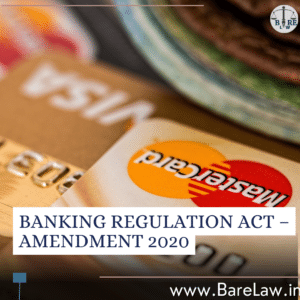Objectives and Applicability of SARFAESI Act, 2002:
The act came into force on June 21st, 2002, and shall extend to the whole of India. The Preamble of the act was substituted in 2016 and currently, it states the objective as to regulate the securitization and reconstruction of financial assets and the enforcement of security interest. Another objective of the act is to provide for a central database of security interests that are to be created on the properties of the persons concerned and also for the matters connected and incidental thereto.
What does Regulation of Securitization mean? As per Investopedia, securitization would generally be the situation when a lender/issuer of money formulates a marketable instrument by grouping or merging various financial assets of the borrower as one asset and later selling the formulated or rearranged assets to the investors. Section 2(z) of the act defines securitization. These are the acts usually done by banks, as they form part of lending money as loans to borrowers. Thus, it is clear that this act applies to those Banks and other financial institutions that are notified under the act. The act enables these banks to sell the assets such as commercial properties etc that were pledged by the borrower through Auctions. Earlier, such a process of recovering the debt or loans from the borrowers took a long time as they have to go through civil proceedings in court. But with the arrival of this act, those banks get the direct power to recover the secured assets that were mortgaged or pledged.
Rights and Functions of Authority:
As mentioned earlier, the reconstruction of assets is effectuated by the company established for this purpose as per section 2(ba) of the act and should have been registered under section 3. Asset reconstruction includes the acquisition of the right or interest of any financial institution by the asset reconstruction company for the realization of financial assistance. Functions of Asset Reconstruction Company has been provided under section 9 and 10 of the act.
As per section 9 of the act, the asset reconstruction company should take measures as per the policies made by the Reserve Bank of India. For this purpose, the asset reconstruction company shall have the following functions or rights. It includes the proper management of the business of the borrower by taking over the management of the business of the borrower, selling or leasing out a part of the business or as a whole, rearranging the payment of debt payable, taking possession over the secured assets as per the provisions of this act. Section 10 of the act provides other functions of the asset reconstruction company. The reconstruction company registered for this purpose can 1) act as an agent for the concerned financial institution 2) act as the manager of the institution and 3) can serve as a receiver is appointed by the court /tribunal.
Dispute Resolution under SARFAESI Act, 2002:
Quite often, the dispute will arise relating to securitization or reconstruction or even for non-payment of loan that is due to any of the parties, i.e. Bank or any Financial Institution or asset reconstruction company. Such a dispute shall be resolved by applying Section 11 of the SARFAESI Act, 2002. It states that in case a dispute arises between the parties concerned as per the provisions of the act, then such dispute shall be resolved by Arbitration or Conciliation mechanism as per Arbitration and Conciliation Act, 1996. This section directly presumes that the parties have consented in writing for determination of such dispute and application of provisions of the act of 1996.
Amendments to SARFAESI Act, 2002
In 2011, the Union government proposed a bill called Enforcement of Security interest and Recovery of debt laws (amendment) bill, 2011 to amend two main acts, those are, 1) SARFAESI Act, 2002 and 2) Recovery of Debts to Banks and Financial Institutions act, 1993. The Bill allowed the banks and the asset reconstruction companies to translate or convert the debt of the defaulter into Equity. This will ensure that the lenders are considered as the equity sharers rather than a creditor of such a company. It also allowed the banks to become bidders of any immovable property that they have proposed for the auction, in case they have no other bidder during the auction. In this way, they can adjust the debts and amount paid by them for the bid, also can they be in a position to secure the assets in the partial fulfillment of the loan that was defaulted by the borrower. They also have been given the option to sell or resale the property to any other bidder after they get control over the same and can clear off the debts.
Recent Developments in SARFAESI Act, 2002
Before 2020, Cooperative banks which are also part of financial institutions were kept away from the application of the SARFAESI Act, 2002 in spite of the same been brought under the purview of Banks through an amendment in 2013. But, the amendment in 2013 was challenged due to its applicability and the authority through which it was enacted. In other words, the amendment was questioned for giving power to parliament for the legislative purpose.
But, later in May 2020, the Supreme Court of India resolved these issues and allowed the co-operative banks to be part of Banks and applicability of the SARFAESI Act to the same. This verdict by the apex court will now help them to recover their long-term bad loans through easier way under the act, 2002.










